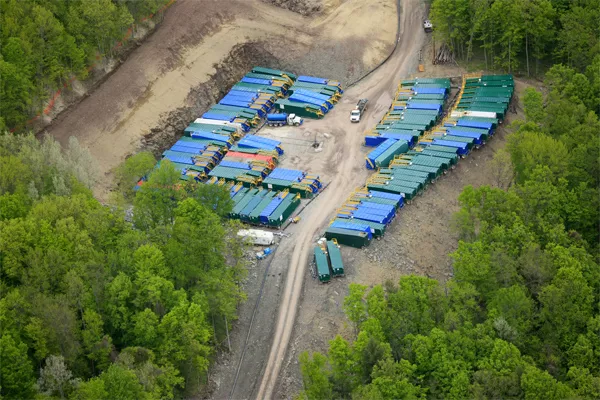Life Cycle of Frac Water

Waste Pit of Hydro-Fracking Drilling Mud, © 2010 J. Henry Fair
The General Cycle
Large quantities of water are needed for the fracturing process. This water is most likely obtained locally, competing with nearby sources.1

Container Trucks with Fracking Liquids at a Drilling Site, Dimock, PA. Photo © 2010 J. Henry Fair.
Millions of gallons of water is injected into the well at high pressure with proppants such as sand and aromatic compounds.2
Flowback water, or water that returns to the surface after the fracking process, is then diverted to brine pits until it is sent to storage tanks, trucked to a local wastewater management facility, or returned to rivers and streams.3,4,5

Source: Bob's Blog. "Our Chunky Frac Water Pt. 2". http://www.donnan.com/fracking-water-2.htm.
A Case Unkown
Currently there is limited information available concerning the life cycle of water used in the hydraulic fracturing process. Despite the growth of interest by state agencies, such as Pennsylvania Departments of Environmental Protection (PA-DEP), interstate river basin commissions, such as the Delaware River Basin Commission (DRBC) and the Susquehanna River Basin Commission (SRBC), community action groups, such as New York based Catskill Mountain Keeper and Pennsylvania based Damascus Citizens, and environmental advocacy groups, such as Earthworks, in issues of water surrounding Marcellus Shale Drilling, there is little compiled evidence that depicts the gap between regulations concerning water use/ disposal and the actualized practices. Stories regarding frac fluid leaks in the drilling process are often profiled, photographs of trucks pumping water out of local rivers surface, and occasional episodes of disaster occurrences at drill sites are propelled to the top of the news heap. While these stories need to be told in light of the lack of awareness, these stories urgently need to be connected to the various regulations that do and do not exist. There exists a need to verify if operators have permits to use water from that particular stream and whether or not they are complying with the regulations that do exist. Doing so will demonstrate the effects of current practices of water use and disposal and help to shape the ways that practices and regulations should be. Or they could point to a moratorium on drilling until more information and assessment is completed.
New Directions
Given the lack of regulation, the gas industry is allowed to set the stakes themselves and define what is and what is not a 'water contamination incident'.6 Accordingly, Lee Fuller, a Vice-President for the Independent Petroleum Association of America, suggests that "there has never been a case of contamination from hydraulic fracturing".7 This happens to be a "semantically based argument", as ProPublica reporter Abrahm Lustgarten states in a recent podcast.8 According to Fuller, in dialogue with ProPublica, "hydro fracking is the moment the pressure of the fluids within the well begin to fracture rock" (emphasis added).9 As such, any incident occurring outside of this moment, but related to the process is excluded in this consideration.
The Environmental Protection Agency, however, is working to investigate Marcellus Play incidences and in doing so, possibly reframe the way in which drilling should occur. For starters, "a lifecycle approach" to understanding potential implications of drilling goes a long way in devising possible long-term plans and assessment for Marcellus Shale activity.10One major issue that will be profiled in the agency's upcoming reports, is wastewater management currently and what it is to be in the future. The question, 'where is the flow back water to go?' remains insufficiently unanswered. According to estimates, the report being undertaken will be available in 2012, at the end of President Obama's first term.11
References
1. Columbia University Urban Design Lab. Hancock and the Marcellus Shale. New York: Columbia University Urban Design Lab, 2009. Print.
2. Horwitt, Dusty. "EWG Warns of Drilling Threat to NYC Drinking Water | Environmental Working Group." EWG Home | Environmental Working Group. Web. 01 May 2010. <http://www.ewg.org/EWG_Warns_of_Drilling_Threat_to_NYC_Drinking_Water>.
3. United States. Susquehanna River Basin Commission. Accommodating a New Straw in the Water: Extracting Natural Gas from the Marcellus Shale in the Susquehanna River Basin. Web. 01 May 2010.
4. United States. Pennsylvania Department of Environmental Protection. Marcellus Shale Wastewater Partnership. Wastewater Management for High TDS Wastewater in Pennsylvania. Print.
5. "Flowback Water - Wikimarcellus." Tom Copley's - Homepage. Web. 01 May 2010.
6-9.Webb, Mike. "Joaquin Sapien and Abrahm Lustgarten on the EPA and Gas Drilling." Audio blog post. ProPublica. 12 Apr. 2010. Web. 01 May 2010. <http://www.propublica.org/ion/podcast/item/11-joaquin-sapien-and-abrahm-lustgarten-on-the-epa-and-gas-drilling-by-mike>.
10-11. Lustgarten, Abrahm. "Broad Scope of EPA's Fracturing Study Raises Ire of Gas Industry."ProPublica. 07 Apr. 2010. Web. 28 Apr. 2010. <http://www.propublica.org/feature/broad-scope-of-epas-fracturing-study-raises-ire-of-gas-industry>.



